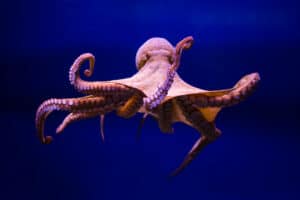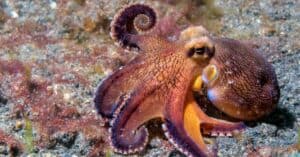Octopuses are extremely popular worldwide as a culinary delicacy. However, these creatures represent much more than just meat. Did you know that they are considered the smartest invertebrates?! That’s only natural since they have nine brains and 180 million neurons! Moreover, can you believe that they have three hearts? These intelligent creatures are full of surprises!
One of the curious things about these aquatic animals is their digestive system. Many people believe they poop out of their mouths. But do they really? Let’s find out! Today we’ll tell you everything about an octopus’ digestive system. You’ll also find out what it eats, how it poops, and what its waste looks like!
What are octopuses?

An octopus is an invertebrate animal that belongs to the
Octopodaorder.
©iStock.com/richcarey
Fossil records suggest octopuses appeared more than 296 million years ago! They are invertebrate animals belonging to the Octopoda order. More than 300 octopus species grouped into 13 families roam in the depths of the world’s waters, mostly in tropical and temperate seas.
Here are some of the most beautiful and known octopus species:
- The Flapjack Octopus (Opisthoteuthis californiana)
- The Giant Pacific Octopus (Enteroctopus dofleini)
- The Atlantic Pygmy Octopus (Octopus joubini)
The giant Pacific octopus is the largest species, having an arm span of up to 14 feet and weighing approximately 33 pounds. The official record was set by a 156.5-pound octopus, although unofficial records say that much bigger octopuses live out there. The smallest species is the Octopus wolfi, also called the star-sucker pygmy octopus, whose average arm span is 1 inch and whose weight is less than 0.04 ounces.
Octopuses are known for their four pairs of arms, which are biologically called appendages. These arms surround the octopus’ mouth. Octopuses use their two rear arms to walk and their other six to look for food. They also have a mantle that hosts most of the animal’s organs.
What do octopuses eat, and what eats them?
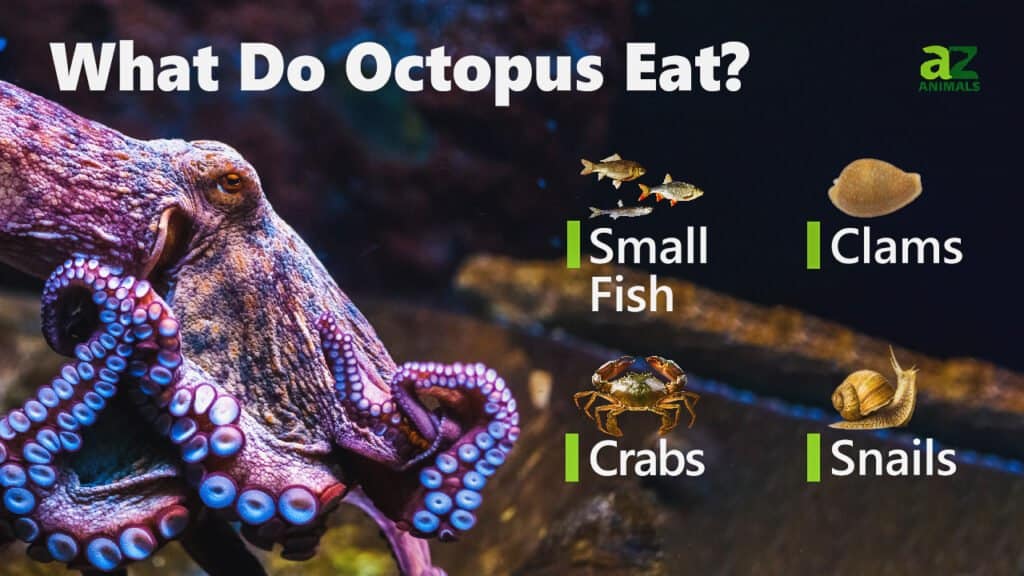
Octopuses are carnivorous animals. Their primary food source consists of crabs and other crustaceans. Here’s a list of what octopuses eat:
These animals may fall prey to various marine fishes, seabirds, sea otters, and other cephalopods. Besides this, humans are a big threat to octopuses because they regularly hunt them for culinary purposes.
An octopus’ primary defense mechanism is ejecting ink. This black ink is used to cover them while they get away from a predator. Moreover, some species’ ink is venomous and can paralyze the attacker.
What does octopus poop look like?
Octopus droppings consist of very thin and long strings of white poop. They do not smell. A study shows that octopus feces tell a lot about their bodies. This specific research focused on analyzing the “data” from the feces of Pacific octopuses to establish the levels of estrogen, progesterone, testosterone, and corticosterone. As for vertebrates, these could point to their ovarian activity and stress levels, which is a big success, as there are currently few studies on fecal hormones in invertebrates.
Do octopuses poop from their mouths?
No, octopuses do not poop from their mouths. Their mouths are only used for ingesting food. Octopuses’ waste leaves the body through their anuses located before the funnel, sometimes called a siphon. The tunnel is located on the side of an octopus’ mantle.
How do octopuses digest food?
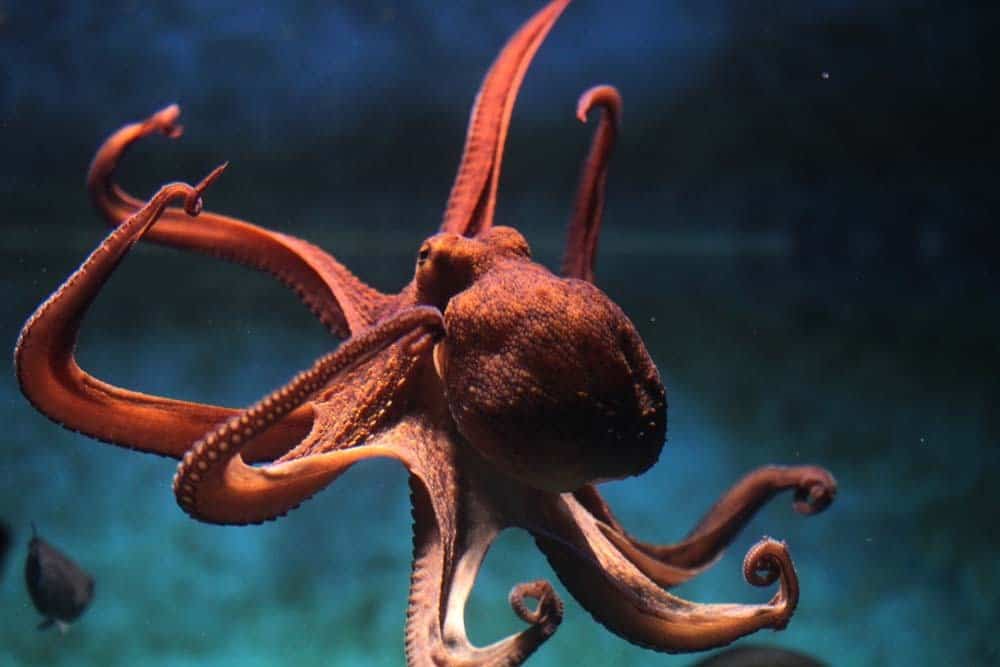
Octopuses have two pairs of salivary glands; one secretes digestive enzymes, and the other secretes cephalotoxin.
©Vladimir Wrangel/Shutterstock.com
Octopuses’ digestive systems resemble those of other cephalopods. First, they have inner and outer lips located around the mouth. In turn, these lips have ridges and papillae. Octopuses have two pairs of salivary glands; one secretes digestive enzymes, and the other secretes cephalotoxin, used to immobilize the prey.
From their mouth, the food goes into the esophagus, which connects the mouth to the crop. The crop is used for storing food. After this, it goes into the stomach. Here’s where the interesting part comes. Unlike a human’s stomach, which produces digestive enzymes, an octopus’ stomach doesn’t do anything like that. Instead, their liver produces enzymes that get into the stomach to digest the food. The food molecules then go back to the liver, where nutrients are absorbed and transmitted to the other body parts. What’s left goes into the intestine and exits the body through the anus, located before the funnel (also called a siphon) that is used to pass the water out.
Are octopuses dangerous to humans?
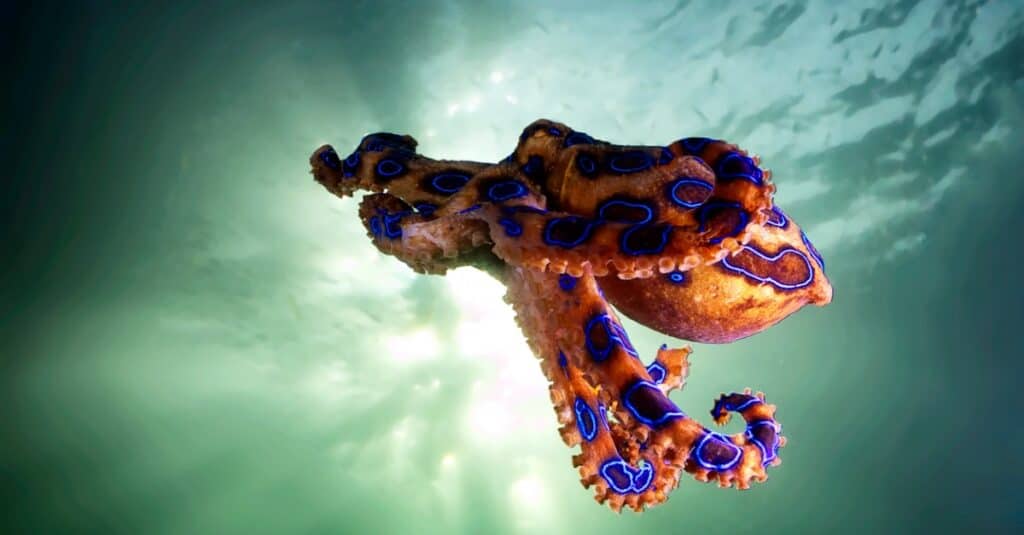
The blue-ringed octopus is the only octopus that contains venom that is poisonous to humans.
©iStock.com/Subaqueosshutterbug
The blue-ringed octopus, which is, in fact, a genus that consists of multiple species, is the only octopus that contains venom that is poisonous to humans. This octopus lives in waters ranging from the Sea of Japan to those of southern Australia, as well as all the way from the Philippines to Vanuatu.
Blue-ringed octopuses have killed two people in Australia and one in Singapore. Their venom is life-threatening and even fatal to humans. Their venom paralyzes the victim, who remains completely conscious. Eventually, the victim’s death is caused by a lack of oxygen. However, if mouth-to-mouth resuscitation is possible, the risk of an octopus bite being fatal diminishes.
Incredible Octopus facts
- Octopuses have extremely flexible bodies, making it easy to squeeze into openings as small as one inch.
- Octopuses have three hearts! Two hearts pump blood through the gills. The third heart pumps blood throughout their bodies.
- Octopuses might have both short and long-term memory! This is suggested by the fact that they could easily find their way back during maze-solving experiments!
- The dumbo octopus lives at depths of 13,100 feet beneath the surface!
- Octopuses have blue blood! This is caused by the copper in the hemocyanin protein, which carries oxygen through the body. In humans, the red blood color is caused by the iron in the hemoglobin.
- Octopuses are known to have nine brains with about 180 million neurons!
The photo featured at the top of this post is © Andrea Izzotti/Shutterstock.com
Thank you for reading! Have some feedback for us? Contact the AZ Animals editorial team.



